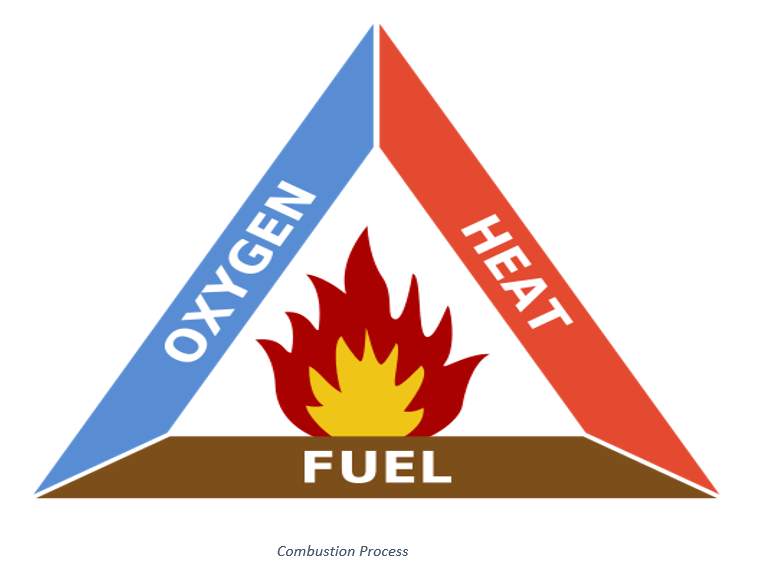Combustion DefinitionCombustion is a chemical process in which a fuel combines with oxygen, producing heat and light. During combustion, the fuel reacts with oxygen in the air to release energy in the form of heat and light, and the products of the reaction are usually carbon dioxide and water vapor. 
This chemical reaction requires three things: fuel, oxygen, and heat. The fuel can be any substance that can burn, such as wood, coal, gasoline, or natural gas. Oxygen is present in our air; a spark, flame, or ignition can provide heat. The reaction during combustion is an oxidation reaction, which means that oxygen is added to the fuel to produce energy. This energy is released in the form of heat and light. It can be harnessed for various purposes, including cooking, heating homes and buildings, and powering engines. What is Combustion?Combustion is a chemical reaction between a fuel and an oxidizer that produces heat and light. This reaction typically involves the fuel combining with oxygen from the air to form new compounds, such as carbon dioxide, water vapor, and other combustion by-products. The chemical equation for combustion can be represented as follows: Fuel + Oxygen = Carbon Dioxide + Water + Heat The fuel can be any substance that can burn, including organic compounds such as wood, coal, natural gas, and gasoline, as well as metals and other materials. The oxidizer is usually oxygen, although other substances, such as chlorine and fluorine, can also be used in specific combustion reactions. The heat and light produced by combustion are the results of the release of energy that occurs when the fuel and oxidizer react. This energy is used in various applications, including heating homes and buildings, powering vehicles and machinery, and generating electricity. However, combustion also produces harmful pollutants such as carbon monoxide, nitrogen oxides, and particulate matter that can negatively affect the environment and human health. As a result, scientists are continually researching and developing new technologies and methods to make combustion more efficient and cleaner and find alternative energy sources to reduce our dependence on fossil fuels. Types of Combustion1. Complete CombustionWhen we burn fuel with enough oxygen, it can undergo complete combustion, which is a fancy way of saying that it reacts with oxygen to produce carbon dioxide and water vapor. This process is efficient and clean, which is excellent for the environment and our health. Complete combustion usually happens when we burn hydrocarbon fuel, a molecule of carbon and hydrogen atoms. One example of hydrocarbon fuel is methane (CH4), which can undergo complete combustion when it reacts with oxygen. Overall, complete combustion is good because it produces minimal pollutants and releases much energy. It is essential to use clean and sustainable fuel sources to promote complete combustion and reduce the harmful effects of incomplete combustion on our environment and health. CH4 + 2O2 = CO2 + 2H2O In this reaction, when methane is burned in the presence of oxygen, it can undergo complete combustion and produce carbon dioxide and water vapor as the main products. This process requires two molecules of oxygen for every molecule of methane that is burned. It is characterized by a blue flame that indicates clean and efficient burning with maximum energy output and minimal pollutants. However, complete combustion is not always possible or desirable in every situation. Sometimes there may not be enough oxygen available for complete combustion, leading to incomplete combustion that produces harmful pollutants such as carbon monoxide and nitrogen oxides. In addition, the complete combustion of fossil fuels such as coal, oil, and gas contributes to climate change by releasing large amounts of carbon dioxide into the atmosphere. As a result, there is a growing need to develop cleaner and more sustainable forms of energy that produce fewer greenhouse gases and other pollutants. This can involve using renewable energy sources such as solar or wind power or developing technologies that allow for more efficient and cleaner burning of fossil fuels. By reducing our reliance on fossil fuels and promoting cleaner energy sources, we can help mitigate the negative effects of incomplete combustion and reduce our environmental impact. 2. Incomplete CombustionIncomplete combustion happens when fuel is burned with limited oxygen, which makes incomplete combustion products like carbon monoxide, soot, and other pollutants. This can happen when there is insufficient oxygen to react fully, or the combustion process gets messed up. The fuel in incomplete combustion is usually a hydrocarbon, a molecule with carbon and hydrogen atoms. For instance, natural gas burned with a limited oxygen supply could undergo incomplete combustion. CH4 + O2 → CO + H2O + heat Incomplete combustion occurs when a fuel is burned with limited oxygen, producing carbon monoxide, water vapor, and heat. Unlike complete combustion, which burns fuel cleanly and efficiently, incomplete combustion produces an orange or yellow flame. It can be harmful to both human health and the environment. This is because incomplete combustion produces pollutants such as carbon monoxide and soot, which can contribute to air pollution. Incomplete combustion can happen in various situations, such as when furnaces or heaters are not well-maintained or when vehicles have faulty engines. It can also be used intentionally when producing charcoal or other fuels requiring limited oxygen. It is essential to recognize the effects of incomplete combustion and take steps to reduce its occurrence. By correctly maintaining combustion systems and finding alternative energy sources, we can minimize the negative impact of incomplete combustion on our health and the environment.
Next TopicComputer Definition In English
|
 For Videos Join Our Youtube Channel: Join Now
For Videos Join Our Youtube Channel: Join Now
Feedback
- Send your Feedback to [email protected]
Help Others, Please Share









